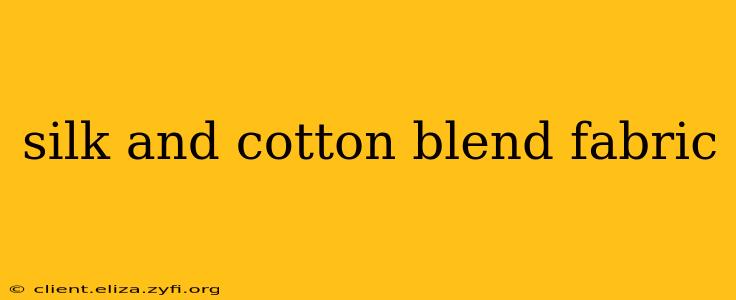Silk and cotton blend fabrics offer the best of both worlds: the luxurious feel of silk and the breathability and durability of cotton. This versatile blend creates a unique textile prized for its comfort, drape, and versatility in various applications, from clothing to bedding. This comprehensive guide will explore the characteristics, benefits, care instructions, and uses of silk and cotton blend fabrics.
What is Silk and Cotton Blend Fabric Made Of?
Silk and cotton blend fabrics are precisely what their name suggests – a combination of silk and cotton fibers woven together. The exact proportions of each fiber vary depending on the desired qualities of the final fabric. A higher silk content will result in a smoother, more luxurious feel and drape, while a higher cotton content will enhance durability and breathability. The blending process itself can be achieved through several methods, influencing the final texture and appearance of the fabric.
What are the Benefits of Silk and Cotton Blend Fabric?
The benefits of choosing a silk and cotton blend are numerous, making it a popular choice for a wide array of applications.
- Softness and Comfort: The blend combines the inherent softness of both silk and cotton, resulting in a luxuriously comfortable textile against the skin. This makes it ideal for clothing like shirts, pajamas, and lingerie.
- Breathability: Cotton's inherent breathability is enhanced by the silk, creating a fabric that is gentle on the skin and suitable for warmer climates. This breathability prevents overheating and promotes comfort throughout the day.
- Durability: The addition of cotton significantly enhances the durability of the fabric compared to pure silk, which is more delicate. This increased resilience makes the blend suitable for items that require more frequent washing and wear.
- Drape and Flow: While not as dramatically flowing as pure silk, a silk and cotton blend still boasts an elegant drape, making it ideal for garments that require a graceful silhouette.
- Hypoallergenic Properties: Both silk and cotton are relatively hypoallergenic, making the blend a suitable choice for individuals with sensitive skin. However, individual sensitivities may vary.
How to Care for Silk and Cotton Blend Fabrics?
Proper care ensures the longevity and beauty of your silk and cotton blend garments. While more durable than pure silk, it still requires gentle treatment:
- Washing: Hand-washing is generally recommended for silk and cotton blends to protect the delicate silk fibers. If machine washing is necessary, use a gentle cycle with cold water and a mild detergent.
- Drying: Always air dry your silk and cotton blend garments. Avoid using a dryer, as the heat can damage the fibers and cause shrinkage.
- Ironing: Ironing should be done on a low setting with a pressing cloth to prevent scorching.
What are the Different Types of Silk and Cotton Blends?
The exact ratio of silk and cotton influences the fabric's final properties. A 70/30 blend (70% cotton, 30% silk) will be more durable and breathable than a 30/70 blend (30% cotton, 70% silk), which will offer a more luxurious drape and feel. There isn't a standardized naming convention for specific blends; however, manufacturers often specify the blend percentage on the care label.
What are the Common Uses of Silk and Cotton Blend Fabrics?
Silk and cotton blends are used extensively in a variety of applications:
- Clothing: Shirts, blouses, pajamas, dresses, lingerie, and scarves are popular choices.
- Bedding: Sheets, pillowcases, and duvet covers made from this blend offer a luxurious and comfortable sleeping experience.
- Home Decor: Draperies, upholstery, and other decorative items can be made from this fabric.
Is Silk and Cotton Blend Fabric Expensive?
The cost of silk and cotton blend fabrics varies depending on the proportion of silk used, the quality of the fibers, and the manufacturing process. Generally, it is less expensive than pure silk but more costly than pure cotton.
How Does Silk and Cotton Blend Compare to Other Fabrics?
Compared to pure silk, a silk and cotton blend offers greater durability and washability. Compared to pure cotton, it provides a more luxurious feel and drape. When compared to other blends, like silk and linen or silk and modal, the cotton blend offers a good balance of breathability, softness, and durability.
This article aims to provide a comprehensive overview of silk and cotton blend fabrics. Remember to always check the care label for specific washing and ironing instructions to best preserve the quality of your garment or textile.
